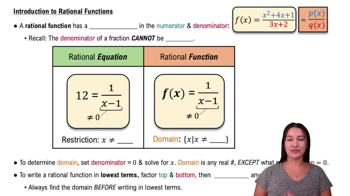Table of contents
- 0. Functions7h 52m
- Introduction to Functions16m
- Piecewise Functions10m
- Properties of Functions9m
- Common Functions1h 8m
- Transformations5m
- Combining Functions27m
- Exponent rules32m
- Exponential Functions28m
- Logarithmic Functions24m
- Properties of Logarithms34m
- Exponential & Logarithmic Equations35m
- Introduction to Trigonometric Functions38m
- Graphs of Trigonometric Functions44m
- Trigonometric Identities47m
- Inverse Trigonometric Functions48m
- 1. Limits and Continuity2h 2m
- 2. Intro to Derivatives1h 33m
- 3. Techniques of Differentiation3h 18m
- 4. Applications of Derivatives2h 38m
- 5. Graphical Applications of Derivatives6h 2m
- 6. Derivatives of Inverse, Exponential, & Logarithmic Functions2h 37m
- 7. Antiderivatives & Indefinite Integrals1h 26m
- 8. Definite Integrals4h 44m
- 9. Graphical Applications of Integrals2h 27m
- 10. Physics Applications of Integrals 2h 22m
2. Intro to Derivatives
Derivatives as Functions
Problem 3.1.58
Textbook Question
Find the function The following limits represent the slope of a curve y = f(x) at the point (a,f(a)). Determine a possible function f and number a; then calculate the limit.
(lim x🠂2) 1/x+1 - 1/3 / x-2
 Verified step by step guidance
Verified step by step guidance1
Step 1: Recognize that the given limit represents the derivative of a function at a point. The expression \( \lim_{{x \to 2}} \frac{\frac{1}{x+1} - \frac{1}{3}}{x-2} \) is in the form of the definition of the derivative \( f'(a) = \lim_{{x \to a}} \frac{f(x) - f(a)}{x-a} \).
Step 2: Identify the function \( f(x) \) and the point \( a \). From the expression \( \frac{1}{x+1} \), we can deduce that \( f(x) = \frac{1}{x+1} \). The point \( a \) is given by the limit \( x \to 2 \), so \( a = 2 \).
Step 3: Calculate \( f(a) \). Substitute \( a = 2 \) into \( f(x) \) to find \( f(2) = \frac{1}{2+1} = \frac{1}{3} \). This matches the \( \frac{1}{3} \) in the limit expression, confirming our function and point.
Step 4: Set up the derivative calculation. The derivative \( f'(x) \) is given by \( \lim_{{x \to 2}} \frac{f(x) - f(2)}{x-2} = \lim_{{x \to 2}} \frac{\frac{1}{x+1} - \frac{1}{3}}{x-2} \).
Step 5: Simplify the expression to find the limit. Combine the fractions in the numerator: \( \frac{1}{x+1} - \frac{1}{3} = \frac{3 - (x+1)}{3(x+1)} = \frac{2-x}{3(x+1)} \). Substitute this back into the limit: \( \lim_{{x \to 2}} \frac{\frac{2-x}{3(x+1)}}{x-2} \). Simplify and evaluate the limit.
 Verified video answer for a similar problem:
Verified video answer for a similar problem:This video solution was recommended by our tutors as helpful for the problem above
Video duration:
6mPlay a video:
Was this helpful?
Key Concepts
Here are the essential concepts you must grasp in order to answer the question correctly.
Limits
Limits are fundamental in calculus, representing the value that a function approaches as the input approaches a certain point. In this context, the limit helps determine the slope of the curve at a specific point, which is essential for understanding the behavior of the function near that point.
Recommended video:

One-Sided Limits
Derivatives
The derivative of a function at a point gives the slope of the tangent line to the curve at that point. It is defined as the limit of the average rate of change of the function as the interval approaches zero. In this problem, finding the derivative at the point (a, f(a)) is crucial for determining the slope of the curve.
Recommended video:

Derivatives
Rational Functions
Rational functions are ratios of polynomials, and they often require careful analysis when evaluating limits, especially when approaching points where the function may be undefined. In this question, the limit involves a rational expression, and understanding how to simplify or manipulate such expressions is key to finding the desired limit.
Recommended video:

Intro to Rational Functions
Related Videos
Related Practice



